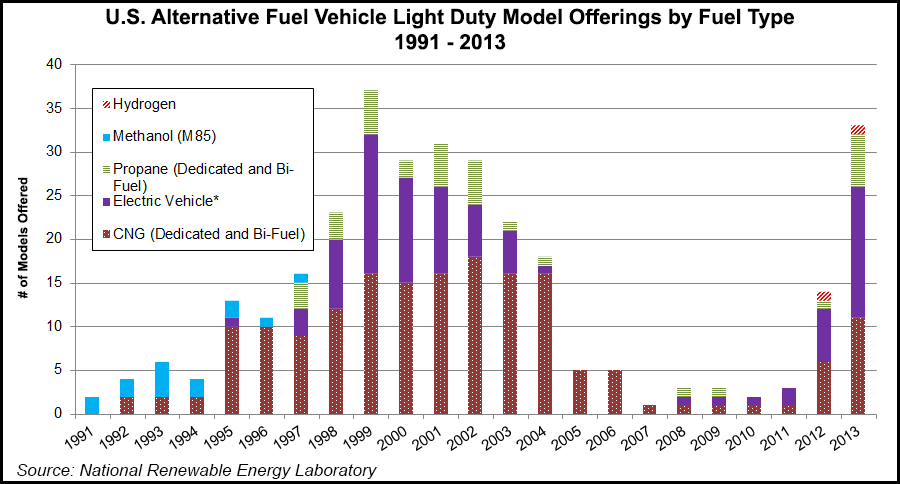NGI Archives | NGI All News Access
Global View of Natural Gas Vehicles Changing
While the saturation of natural gas vehicles (NGV) in other parts of the world, such as Italy and Brazil, is much deeper in the passenger car market and taxis than in North America, overseas and U.S. markets share some of the same questions and concerns, judging from a panel at the NGV Global joint program Thursday at ACT Expo in Long Beach, CA.

Panelists from the United States, Europe and South America talked about global issues needing to be resolved in terms of standardization for fuel, equipment and vehicles, along with regulations and certifications.
If the U.S. NGV market can be characterized in a word, Mats Ekelund, a partner/senior adviser at Sweden’s Strateco, would call it “fragmented,” with too little standardization and too much reliance on lightly regulated after-market retrofit solutions, instead of an emphasis on original equipment manufactured (OEM) compressed natural gas (CNG) and liquefied natural gas (LNG) vehicles.
Richard Kolodziej, president of NGVAmerica, the panel moderator, said in the heavy duty vehicle sector OEMs are the dominant providers, but in the rest of the U.S. segments he agreed there is fragmentation. Kolodziej would advocate that the U.S. industry build on the heavy duty experience in the light- and medium-duty vehicle space.
Jeffrey Seisler, a global NGV consultant who founded the original national NGV Coalition in the United States in the 1980s and went on to found a similar organization in Europe, advocated the need for “harmonizing standards and regulations” on a global basis while allowing governments to take strong roles in shaping markets for NGVs.
“The good news is that after many years, ISO [International Organization of Standardization] has approved standards for both LNG and CNG stations, and they become effective in 2015,” said Seisler, who called the standards and regulations a “critical element” for NGV growth globally. Ultimately, he said, “governments are essential to successful [alternative fuels] markets.”
Seisler thinks there needs to be more focus and synergy in the United States, concentrating on ready made markets such as taxis and ports where trains, trucks and ships all converge, and all are potential users of natural gas. In Germany there is already a focus on the taxi market, he said.
Even with concerted efforts of nations and the industry, the global transition to new transportation fuels is going to take a very long time, Seisler said. “Even the best fuel to replace gasoline is going to take decades to work out [all the complex of technical, political and economic issues]. The future is a big place, and it will take a long time to get there.”
Ekelund, who stressed the need for greater cooperation between the industry and government at all levels, said one of his impressions of the U.S. NGV sector is that it is “not very careful with markets.” Over recent years, market segments have started and died repeatedly, he said.
Kolodziej said one of the problems in the United States is “that we’re trying to do everything, while Sweden has focused on light-duty vehicles primarily.” Ekelund disagreed with thatcharacterization.
Mariarosa Baroni, CEO of NGV Italy, advocated more regulation and training in the after-market, where upfitters modify OEM vehicles to run on CNG or LNG. “In the United States, I think you need first a good training program for the after-market,” Baroni said.
In Brazil, where there are 1.7 million CNG vehicles, there has been little penetration with fleets — only 4% have converted to CNG — according to Jorge Mathuiy, director at MAT SA and a member of the Brazilian Petroleum and Gas Institute’s NGV Committee.
While CNG can be found at most fueling stations that offer gasoline, ethanol and propane, Mathuiy characterized the Brazilian CNG market as “very difficult” because there is very little government oversight or incentives. “We don’t have fundamental government support,” he said.
© 2024 Natural Gas Intelligence. All rights reserved.
ISSN © 1532-1231 | ISSN © 2577-9877 |
